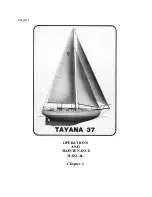
1-15
220 Dauntless
Section 1 • Safety
R
To avoid boating in unsafe areas where there are
underwater obstructions, shallow water, unnavigable
conditions such as dangerous currents, and others,
you must chart a course. this means having and
using National Oceanic and Atmospheric
Administration (NOAA) charts for coastal waters,
observing and understanding all navigational aids,
using the knowledge and guidence of experienced
boaters, and being aware of the tides and times where
appropriate. If you are boating in an area you are
unfamiliar with, proceed with caution and post a
lookout to watch for hazards.
Chart Your Course
Float Plan
Float plans are important to you should you encounter
problems on the water. A float plan will describe
where you will be boating, departure time and return,
number and names of passengers, and destination
should be noted. The float plan should be given to a
friend or relative, so they can give the information
to a national boating agency like the U.S. Coast
Guard, in the event you do not return at the time
specified on the float plan. If there are any changes
to the float plan they should be conveyed to the
person holding the float plan. Once you return you
should contact the person holding the float plan to
let them know you are back.
Hitting an object in or under the water or
boating in dangerous currents can cause serious
injury or death to occupants in the boat.
You must know where the hazards are and avoid
them. In uncharted waters, boat very slowly
and post a lookout.
If an object is struck or if you run aground:
• Shut the engine OFF
• Check the hull for damage
• Check propeller for damage
• If aground, consider the bottom
grade before moving off, (damage
to the hull and propellers could be
worsened).
• Determine the tides and whether it
will help or hinder you from the
grounding.
• Do not have anyone other than a
trained and competent service tow
your boat.
!
WARNING
Accidental loss of power can be hazardous,
particularly while docking or in heavy seas, strong
current or high winds. Passengers and crew may lose
balance and the boat may lose steering control.
Should the operator fall out of the boat at planing
speed, it may take several seconds for the engine and
propeller to stop turning. The boat may continue to
coast for several hundred feet, causing injury to
anyone in its path.
Environmental Considerations
Fuel & Oil Spillage
Regulations prohibit discharging fuel or oily waste in
navigable waters. Discharge is defined as any action
which causes a film, sheen or discoloration on the water
surface, or causes a sludge or emulsion beneath the
water surface. A common violation is bilge discharge.
Use rags or sponges to soak up fuel or oily waste, then
dispose of it properly ashore. If there is much fuel or oil
in the bilge, contact a knowledgeable marine service to
remove it. Never pump contaminated bilge overboard.
Help protect your waters.
















































